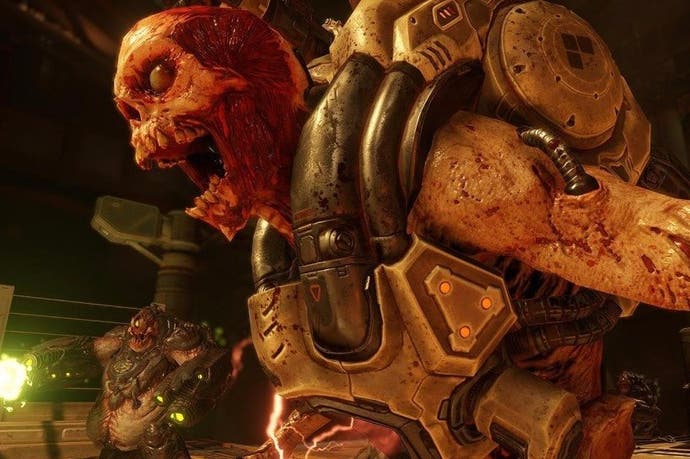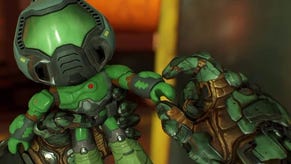The guy you're playing as in Doom is playing Doom
Death meta.
Tricky one, Doom. Tricky one to reboot, or deboot, or whatever it is that id Software has been tasked with this time around. Tricky lineage to negotiate. How do you expand upon a game whose force and purity all but created the pace, mechanics, and look of a generation of shooters? How do you do that, all the while knowing that in the sheer unadorned potency of the original game there is something that can only ever be damaged by elaboration? Returning to Doom, surely the temptation is to make Doom more complex - but complexity only makes it less like Doom. Amazingly, though, despite the odds stacked against it, the new Doom feels a lot like, well, a lot like Doom. It has that same headlong rush, that same engine of wet splatter chugging everything forward. I've been playing through the campaign while trying to work out how they've done it, how developmental hell turned out a game that is such a joyous blast to play. And I think a big part of the game's success comes down to one weird thing: the guy you're playing as in Doom is playing Doom.
Before we go any further I should probably add that the guy you're playing as in Doom is also, for most of the campaign, just an arm. Okay, two arms on the rare occasion when he needs to smash a fist into his palm or yank apart a set of jammed doors. Doom isn't the first game to do this by any means - it's not the first game to give you a near silent protagonist, or give its first-person camera some kind of presence in the world. What's different about Doom is how much charm it gets into such a small set of animations. This Doom, above and beyond all other things, is a game of great charm.
So yes, the guy in Doom is playing Doom. You can tell this from his heady mixture of enthusiasm and impatience that permeates all his actions. Look at him picking up a new weapon: the sheer joy with which he reaches for the chainsaw or the rocket launcher. "You! Here?" he seems to be thinking. "You are really going to help me with the next bit of Doom that comes around the corner!" Look at him mantling, hands gripping platforms and pulling him up with the breathless pace of a kid at their first sport's day. Look at him clenching through a health recharge. Look at the way he plays with the bobblehead secrets he finds littered around the place. This isn't a person who's worried about wormholes from Hell and all the shady things a Martian drilling company has been doing on the sly. This is a guy who's just glad to be locked in a building with a bunch of shambling jelly people to shoot to pieces.
And pulp. Look at that arm as it lunges through the game's Glory Kills system, a neat risk/reward addition that sees you stunning enemies with gunfire before moving in close and meleeing them to earn an extra shower of health orbs along with all the flying viscera. Glory Kills might seem like a nod to the signature takedowns of something like Gears, but it's actually pure Doom, a generous range allowing you to close the gap and actually increase the pace of play. Time it right and you can practically teleport via the medium of crushed skulls and torn limbs. Pure Doom, and the guy you're playing as in Doom knows it: he loves this stuff.
Most tellingly, what doesn't the Doom guy love so much? He doesn't love the plot, which even in a game as bracingly mindless as this still intrudes a little too often. At best, it's a voice comms message coming in from someone corporate and evil, which the guy you're playing as in Doom will silence by wrenching a computer panel off a wall or smashing it to pieces. At worst, it's an agonising full thirty seconds of being locked in a room while plot gets unwound before you. I often can't see the Doom guy's signature arm during these sequences as camera control is taken away, but I can imagine that arm, just out of shot, trembling with the temporary frustration of being inside Doom while not being able to play Doom.
Smashing stuff in a trembling rage is a big part of the arm's job, in fact. The Doom guy's relationship with technology is primitive, functional, and endearingly short-tempered. In other words, this is not his first video game. Elevator buttons are mashed angrily, the track-down-three-of-these doodads that the game's structure relies upon are often yanked from their mountings or punched into fragments when they are eventually located. Upgrade keys are pulled from their sockets in corpse's armour, and when palm prints are needed to open doors, whole palms - and their attendant limbs - are plucked from victims and then slapped on flatscreens, like fish hitting the counter at that fishmonger in Seattle that's always used in training videos.
For all of Doom's legacy, for all of its arena battles and shambling gatefold-art horrors, its treatment of character actually feels rather light touch, rather fresh. Doom's found a way of embracing its inconsequentiality as the ultimate bad-guy-blasting experience. It's found a way of embedding upgrade systems and secrets and all the other things modern games seem to need without letting them take over. It plays a neat trick, a simple trick. Those wider systems are part of a video game you're playing, and you're playing as a very simple guy in this video game: simple and angry and full of life, and look at all the fun he's having. Look at all the fun he's having just playing Doom.










